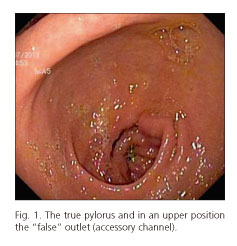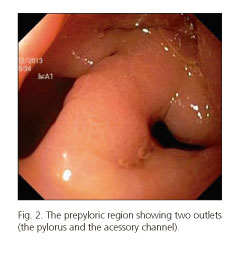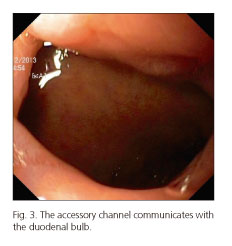My SciELO
Services on Demand
Journal
Article
Indicators
-
 Cited by SciELO
Cited by SciELO -
 Access statistics
Access statistics
Related links
-
 Cited by Google
Cited by Google -
 Similars in
SciELO
Similars in
SciELO -
 Similars in Google
Similars in Google
Share
Revista Española de Enfermedades Digestivas
Print version ISSN 1130-0108
Rev. esp. enferm. dig. vol.107 n.6 Madrid Jun. 2015
PICTURES IN DIGESTIVE PATHOLOGY
Double pylorus
Samuel Costa, Vera Costa Dias, Paula Peixoto, Artur Machado and Raquel Gonçalves
Gastroenterology Department. Hospital de Braga. Portugal
A 65-years-old man with a history of alcoholic liver cirrhosis and gastric peptic ulcer was medicated with esomeprazol and lactulose. Due to intolerance to propranolol, he was referred to our institution to perform primary prophylaxis of esophageal variceal bleeding with band ligation.
In the esophagogastroduodenoscopy was observed large esophageal varices without red wales; deformation of the gastric antrum and an abnormal communication between the lesser curvature of the antrum and the duodenal bulb. Histology revealed chronic superficial gastritis, without dysplasia or Helicobacter pylori (Figs. 1, 2 and 3).
Double pylorus is a rare condition characterized by the presence of accessory channel extending from the distal stomach to the duodenal bulb (1). It was first reported in 1969 by Smith and Tuttle (2) and in most cases is an acquired complication of chronic peptic ulcer disease (1). Has been reported in 0.001-0.4% of upper gastrointestinal endoscopies (3) and seen twice as often in males when compared with females (4).
It can be found incidentally or present with epigastric pain, dyspepsia, upper gastrointestinal bleeding (1). In general, the patients respond well to conservative treatment for peptic ulcers but fistula closure did not occur in the majority of patients in long-term follow-up (4).
References
1. Lee S-Y, Kim E-S, Cho Y-S. Gastrointestinal: Acquired double pylorus; long term endoscopic observation. J Gastroen Hepatol 2012;27:413. [ Links ]
2. Smith VM, Tuttle KW. Gastroduodenal (pyloric) band. Gastroenterology 1969;56:331-6. [ Links ]
3. Wiseman SM, Tan D, Hill HC. Double pylorus: an unusual endoscopic finding. Endoscopy 2005;37:277. [ Links ]
4. Hu TH, Tsai TL, Hsu CC, et al. Clinical characteristics of double pylorus. Gastrointest Endosc 2001;54:464-70. [ Links ]

















